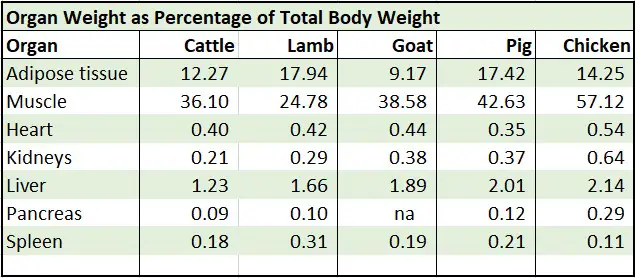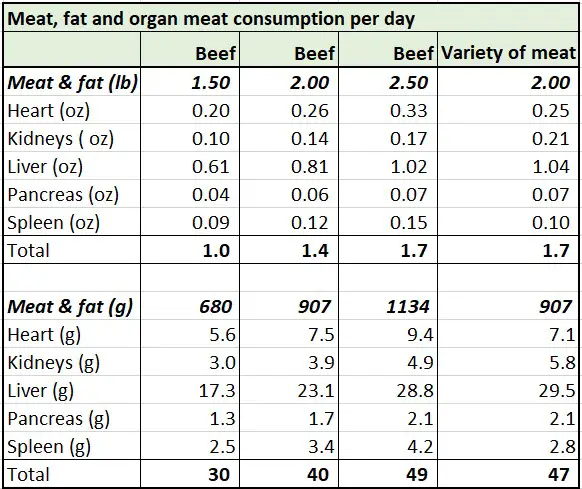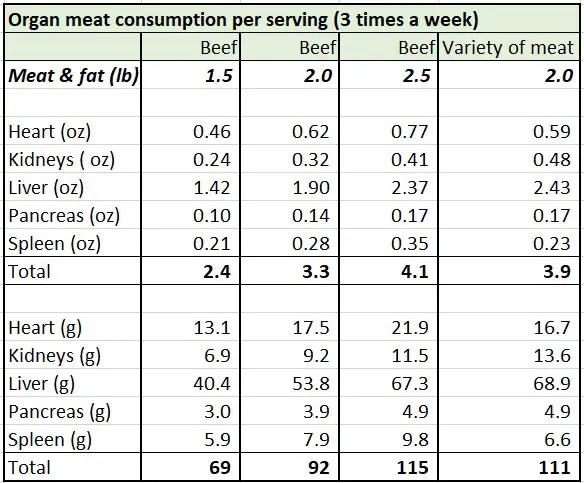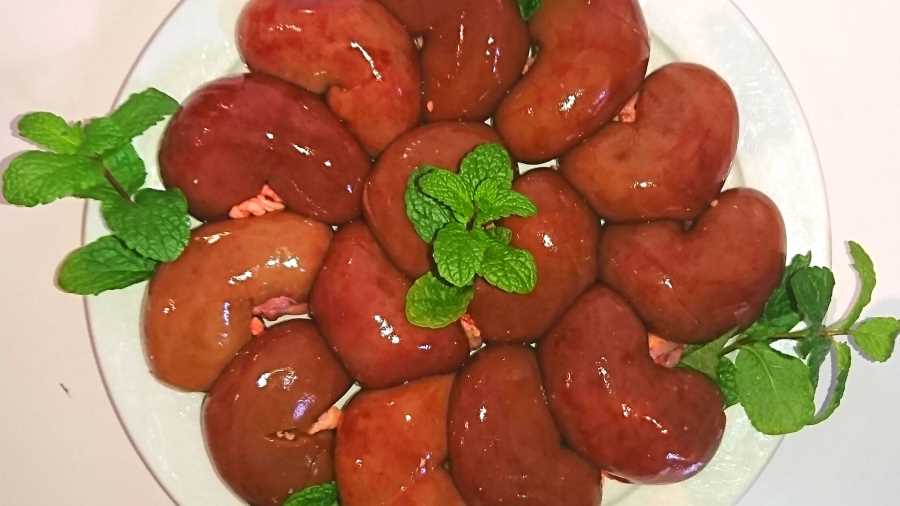Organ meat is the superhero of the carnivore diet. It is the most bioavailable and nutrient-dense food that you can eat. However, too much of a good thing is usually not good for you. This post will look at how much organ meat you should eat on a regular basis on the carnivore diet.
If you eat around 2 lb (~900g) of beef a day and eat organ meat 3 times a week, proportionally, you can eat the following amount per serving:
- 0.62 oz (18 g) of beef heart
- 0.32 oz (9 g) of beef kidney
- 1.90 oz (54 g) of beef liver
- 0.14 oz (4 g) of beef pancreas
- 0.28 oz (8 g) of beef spleen.
Basically, you can have a couple of slices of beef liver and one to two very small slices of other organs (kidneys, heart, pancreas or spleen) per serving.
This does not imply that you should not consume more than these amounts or that there are adverse health implications associated with overconsumption. It just means that if you want to truly eat nose-to-tail, proportionally, these are how much organ meat you should consume.
What are organ meats?
On the carnivore diet, organ meat (offal) generally refers to any odd bits of an animal that are not muscle meat or fat.
Hence there is a very long list of potential organ meat that you can incorporate into your diet, many of which you might have never heard of:
- Liver
- Heart
- Tongue
- Kidney
- Testicle
- Tripe
- Bone marrow
- Brain
- Lung
- Bones
- Pancreas
- Spleen
- Oxtail
- Beef tendon
- Pig ear
- Chicken feet
- Lamb hoof.
Why you should eat organ meat
Organ meats are nutrient gold mines and the real superheroes of the carnivore diet.
In addition to being extremely nutrient-dense, animal organs don’t come with anti-nutrients like oxalate, phytates, tannins, lectins, and phytoestrogens.
This makes them highly bioavailable and that means your body can absorb and utilize more of the nutrients consumed.
Liver
Liver is loaded with so many essential nutrients. It is especially rich in vitamins A and B12 and high in riboflavin (B2), niacin (B3), pantothenic acid (B5), B6, and folate. Liver is also a good source of copper, selenium, phosphorous, zinc, and iron. [1]
Although the liver filters out toxins in an animal’s body, it doesn’t store toxins.
Liver is the most nutrient-dense among all organ meats. If you can choose only one organ meat, liver is what you should go for.
Heart
Heart is a great source of CoQ10, a powerful antioxidant that helps generate energy and has been linked to a number of health benefits. It is also a great source of iron, selenium, B vitamins and zinc. [2, 3, 4]
Heart is more like muscle meat and doesn’t have offal tastes like some other organs.
Kidneys
Kidneys are a great source of thiamin, riboflavin, niacin, B12, iron, phosphorus, copper, and selenium and is relatively high in vitamin C relative to muscle meat. [5, 6]
Brains
Brains are also a good source of an extensive range of vitamins and minerals such as vitamin C, riboflavin, niacin, vitamin B12, vitamin B6, pantothenic acid, iron, phosphorus, copper, and selenium. [7]
Brains are especially high in omega-3 fatty acids and they are great for those who can’t eat fish, can’t afford to buy wild-caught fish, or don’t like fish.
Bone marrow
Bone marrow is a great source of B vitamins, calcium, iron, and vitamin E. [8]
In addition to being a source of many nutrients, there is a group of compounds in the bone marrow called alkylglycerols (AKGs) which have been found to have anti-tumor effects, inhibit the growth of cancer cells and help normalize white blood cell counts in leukemia patients. [9, 10, 11]
Bone broth
Bone broth is full of nutrients including minerals, collagen, glycine, proline, glutamine, glycosaminoglycans, and electrolytes.
In addition to improving bone, joint, and skin health and preserving muscle mass, bone broth can help keep the methionine and glycine balanced. [12, 13, 14, 15, 16]
Methionine and glycine are two amino acids that have an important role in our mental and physical health. Meat is rich in methionine and consuming too much meat can lead to glycine depletion. Because bone broth is rich in glycine, consuming bone broth regularly with meat can help maintain a healthy balance of these two amino acids.
In summary, there are many potential health benefits from practicing eating nose-to-tail and incorporating organ meat regularly into your diet.
The organ meat weights relative to total body weights in cattle, lamb, goats, pigs, and chickens
To work out how much organ meat you should eat on a daily basis, let’s first have a look at the weights of a few common organ meats relative to the total body weights of the animal that you commonly find at the butchers.
The table below shows the weights of a few selected organs as percentages of total body weight for cattle, lamb, goat, pig, and chicken. [17, 18, 19]
Table 1

As you can see, muscle and fat account for the majority of total body weight in these animals. For example, the muscle and fat of cattle (both beef and dairy) account for around 48% of their total body weight.
Vital organs like liver, heart, and kidneys account for a very small percentage of the total body weight of these animals.
For example, liver accounts for around 1-2% of total body weight in cattle, lamb, goats, pigs, and chickens whereas heart and kidneys respectively account for 0.4-0.5% and 0.2-0.6% of these animals’ total body weight.
Since these commonly eaten organs account for a very small percentage of the animals’ total body weights, if you are to eat nose-to-tail, proportionally, you don’t need to eat a lot relative to the amount of meat and fat consumed.
In the section below, we will look at some specific examples of how much organ meat you should eat proportionally to the amount of meat and fat that you consume on a daily basis.
How much organ meat should you eat in a day on the carnivore diet?
The table below shows the amount of organ meat that you should consume in a day relative to the amount of meat and fat that you eat.
Beef and its relative organs (e.g. heart, kidneys, liver, pancreas, and spleen) are chosen because beef appears to be the most commonly consumed meat on the carnivore diet. [20]
Table 2

As can be seen in the table, if you eat around 1.5 lb (680g) of beef a day, proportionally, you can eat:
- 0.2 oz (5.6g) of beef heart
- 0.1 oz (3g) of beef kidney
- 0.61 oz (17.3g) of beef liver
- 0.61 oz (1.3g) of beef pancreas, and
- 0.09 oz (2.5g) of beef spleen.
If your daily meat consumption is around 2.0 to 2.5 lb (~900g to 1.1kg), you can eat a bit more organ meat.
These amounts are calculated based on the relative organ weights as percentages of the total body weight of cattle shown above.
This does not mean that you should not consume more than these amounts or that there are health risks associated with overconsumption. There is yet any evidence to the contrary.
It just means that if you want to truly eat nose-to-tail, proportionally, these are how much organ meat you should consume in a day.
However, assuming you are going hunting with your tribe and sharing every bit amongst the members, the above is a good guide as to how much you should eat.
If you eat a variety of meat (e.g. beef, lamb, goat, pork, and chicken), the last column of Table 2 above shows approximately how much of those organs you should eat in a day.
How much organ meat should you eat per serving if you eat it a few times a week?
If you don’t eat organ meat daily, but eat them a few times a week, you can eat a bit more each time.
The table below shows the amount of organ meat that you should consume per serving if you are to eat it 3 times a week.
As with the above table, these amounts are calculated based on the relative organ weights as percentages of the total body weight of cattle and other animals shown in Table 1 above.
Table 3

If you eat around 1.5 lb (680g) of beef a day and eat organ meat 3 times a week, proportionally, you can eat the following amount per serving:
- 0.46 oz (13g) of beef heart
- 0.24 oz (7g) of beef kidney
- 1.42 oz (40g) of beef liver
- 0.10 oz (3g) of beef pancreas, and
- 0.21 oz (6g) of beef spleen.
If your daily meat consumption is around 2.0 to 2.5 lb (~900g to 1.1kg), you can eat a bit more organ meat.
Other posts you might be interested in:
11 Common Carnivore Diet Mistakes
Is Carnivore the Best Anti-Aging Diet Around?
What Are the Best Ways to Cook Meat on the Carnivore Diet?
How to Lose the Last Few Pounds on the Carnivore Diet?
Do You Have to Eat Organ Meat on the Carnivore Diet?
Disclaimer: The information in this post is for reference purposes only and is not intended to constitute or replace professional medical advice. Please consult a qualified medical professional before making any changes to your diet or lifestyle. Please check out our disclaimer for more detail.





